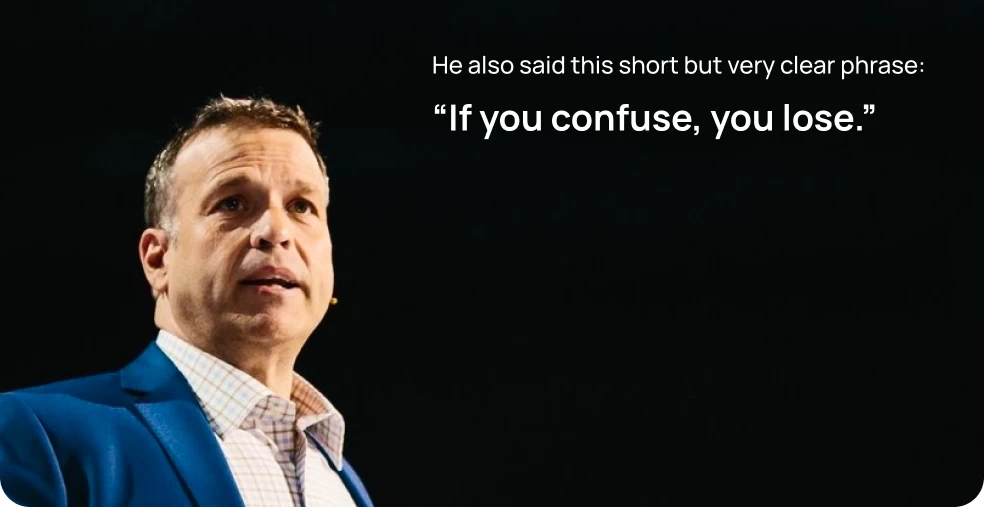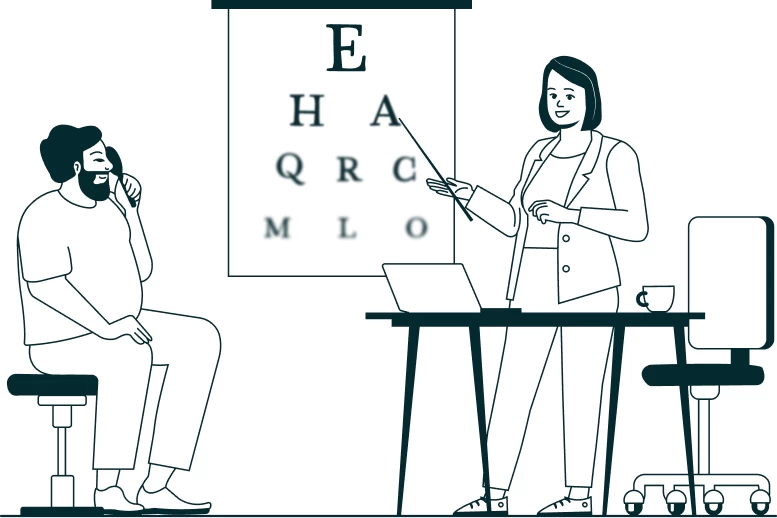Marketing is a mystery for optometry offices. I overheard an optometrist say, “I was told that 50% of your marketing budget is throwing money in the trash. The problem is, you don't know which 50%.
Ouch.
Marketing is a mystery for optometry offices. I overheard an optometrist say, “I was told that 50% of your marketing budget is throwing money in the trash. The problem is, you don't know which 50%.
Ouch.
That’s confusing your patients.

I own a marketing company. What if we met about your marketing, and for the first 15 minutes, I talked about ROI, CPL, CLTV, and CAC,(that’s marketing jargon, by the way)?
You’d be confused and feel like I wasted your time.
Instead, what if I said, “So, you want to get 20 new patients per week and don’t know where to start?”
YES! That’s it!
That’s the power of clear communication and using a story-telling framework, like Donald Miller’s StoryBrand, to position the customer as the hero. That means figuring out what your patient wants, listening for the problem that keeps them from getting what they want, and then demonstrating how you have what it takes to guide them to solve that problem.
Bingo.
For many potential patients, all eye doctors are the same, and frankly, expectations are usually low.
However, as a fantastic eye doc who goes above and beyond to provide an exceptional experience and outcome, your marketing should paint a different picture. Why should your community choose your practice? You likely know the answer. The challenge is clearly communicating the difference.

The StoryBrand framework first teaches us that your patients are the heroes, not you. So, it’s your job to listen to and uncover what your patients want.
That’s easy–great eyesight.
Yes. And every optometrist on the planet promises that.
When we work with optometry offices, we uncover the unique way your office works with patients. You can’t be everything to everyone. Think about your patients. What do they say about your practice? Why do they choose you?

So, what do your patients want?
What is your unique selling point?

Most marketing jumps to how amazing the practice is. Perhaps you have an amazing practice, but customers don’t buy amazing products or services unless they think your amazing product or service will solve their problem.
The list goes on. At Morether, we focus on one main problem your practice solves. The problem you solve should link to your unique selling point.
Yes, you solve a myriad of problems. But we want to keep things simple (remember, if you confuse, you lose).
Decide on the main problem you solve and consider the other problems you solve as “symptoms.” Symptoms are related to the primary issue but not the root cause. So, if your practice solves the problem of an inefficient, backed-up practice and has a warm, welcoming atmosphere, choose one and use the other as another “symptom” you also address.

In your marketing collateral and messaging, talk about the problem you solve until you’re blue in the face. It will feel redundant and boring. But marketing messaging has to hit someone at least a dozen times before they get it.
Talk about the problem you solve.
You’re the guide in this story, not the hero. Most of our favorite guides in movies and books are wise, humble, empathetic, and helpful. They rarely talk about their accomplishments. They are respected for their wisdom.
We can take the same approach in our marketing.
If your marketing launches into how amazing your practice is, you could turn off prospective patients. However, using other people’s words for your authority will draw them in.
How? Testimonials, reviews, and ratings. Implement a feedback loop from your patients and customers. Social proof is the most powerful marketing collateral you can build. Why? Great reviews aren’t easy to get, and the informed consumer knows that.
The experience you provide your customers and your process to gather feedback on their experience through reviews, surveys, and testimonials will set you apart from the rest.
On day one, 7 of 10 people will leave a review.
On day seven, only 3 of 10 people will leave a review.
Research shows when people write down how they feel and why, they defend their stance more strongly than if they do nothing. In other words, you are gaining trust with new patients through reviews and building customer loyalty with your current patients, increasing their lifetime value. Win-win!
Are there other ways to show authority? Of course—the number of years you’ve had your practice, certifications, and the number of patients you’ve treated—all of those matter, but nothing matters more than the words from your patients.
Great guides let others talk about how great they are.

Your patients need help understanding what to expect. About 3% of Americans have never been to an eye doctor, and 28% go every 3-10 years. Unless their experience with your office was traumatic, most people will forget what happens during an eye exam.
A good guide provides a simple plan for the hero. In most movies, heroes aren’t heroes until they’ve conquered the problem. At this stage, your potential patients are skeptical, even fearful, about their journey. A simple plan helps them get past that fear.
Give your patients a simple, 3 to 4-step process plan for the appointment on your website, in email reminders, and through office signage.
1. How to book the appointment
2. What to expect at the appointment
3. How to pay for the appointment
Keep your plan simple. Clarity is king!

As a doctor, you know what success and failure look like regarding people’s vision.
So, in your marketing, paint a picture of what the world would be like if people cared for their eyes. This should be easy. Fewer headaches and neckaches, better sleep, and clearer vision. In the optometry world, we call this “twenty happy.” Life is better when you’re twenty-happy (someone better steal that tagline gold!).
We know people take their vision for granted, and we know the consequences. You don’t have to be Chicken Little, but you need to paint a picture of what can happen if patients don’t prioritize eye care.
A few studies show that when it comes to medical issues, vision loss is at the top of the chart, even over cancer, heart disease, memory loss, and premature death.
Wow.
And marketing studies show that consumers respond more to fear of loss than to desire to gain something.

If you don’t believe me, do a gut check on how you feel when you look at old photos of your kids when they were little. It’s a feeling of loss. The fear of vision loss produces the same emotion.
We are obligated not to manipulate our patients in our marketing. Painting an untrue picture of loss is unethical. However, not painting a picture of what can happen if we neglect our eyes is similarly dishonest. Tell the truth and offer hope.
Your marketing efforts should be informed by the relevant, powerful words, messaging, and phrases you’ve worked on using the StoryBrand framework.
But where should you put these words specifically?
Then, you’re ready to apply these pieces to your marketing.

Work with your office staff to create a process to gather testimonials and reviews.
Add the plan and a clear call to action to your website. Keep it simple, clear, and actionable.
Talk about the problem you solve for your patients on your website, social media posts, and emails. Use empathic statements, such as, “We know waiting at the doctor’s office for hours sounds like a drag” or “We understand what it’s like to feel like a number rather than a real human being at the doctor’s office.”
If your website hero (the first photo people see when coming to your website) is a photo of your building or a local landmark, change it to a photo of happy patients getting their eyes checked or enjoying life with healthy eyes (bonus points if you don’t use stock photos!). Visual imagery paints a picture of success. What does the picture of your office have to do with customer success?
Marketing is complicated, as is taking care of eyes. But your marketing will improve dramatically with the right words and messaging foundation. Using the StoryBrand framework, you can attract the right patients, put their minds at ease that you have what it takes to solve their problems and give them the experience they deserve under your care.
That’s the power of great messaging. It will revolutionize your marketing and business.


Daniel has been a StoryBrand Certified Guide since 2020.
The StoryBrand certification provides intense, ongoing training in the 7-part framework created by Donald Miller.
Additionally, the certification provides a network of marketing brainiacs worldwide. When you’re ready to dial in your marketing, we’ll help you find the 50% marketing that works for you and your business.
As your community grows, your optometry practice needs to grow with it. We help optometrists ditch marketing myopia and scale sustainably.
Clear, simple messaging isn’t easy. As a StoryBrand Certified Guide, I’ve worked with nearly 100 companies to clarify their messaging, helping them find words that resonate with their customers.
I love the challenge, so I offer a 30-minute “Fix My Messaging” session to optometrists willing to give their marketing the time and effort it deserves.
Marketing your optometry practice can feel overwhelming, But with the right messaging, you can have a winning foundation to help transform your practice into the thriving business you want it to be.